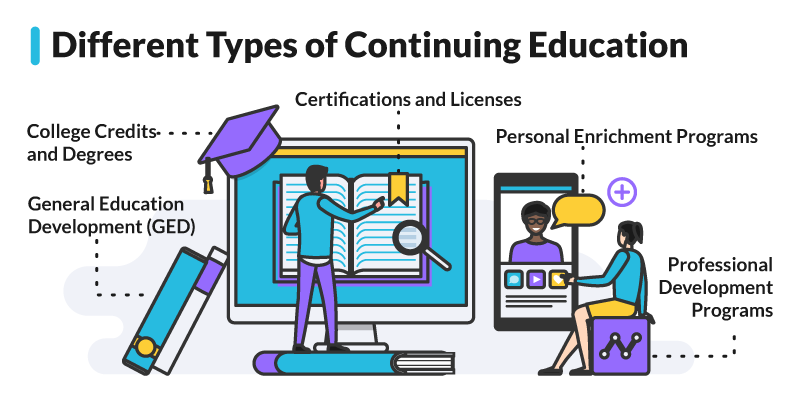Continuing education provides impactful learning opportunities outside of formal degree programs to acquire new skills and credentials that can propel careers. However, to gain the full value, professionals should follow an intentional process to select and apply continuing education in ways that maximize career benefits. Here we explore best practices for leveraging continuing education for advancement.
Assess Goals & Identify Needs
The first step is conducting self-reflection to get clear on career aspirations and discern current capability gaps holding you back.
- What positions or job levels do you aim to reach long-term?
- What qualifications, skills, or connections could build a bridge to new opportunities?
- What strengths would you like to build on more directly in your work?
- What emerging industry trends or technologies should you get up to speed on?
Assessments like LinkedIn’s Career Explorer, Gallup’s StrengthsFinder, or job listing analysis help uncover targets. Being mindful of emerging needs versus simply reacting to urgent issues alone enables more strategic professional development.
Explore Program Options
Once target skills to build are identified, researching the diversity of continuing education options allows finding the best fit.
- Degrees & Certificates – Community college, university, technical/vocational programs
- Online Courses – MOOCs, bootcamps, individual classes
- Conferences – Professional association meetings with workshops
- Seminars/Classes – Short evening or weekend courses
Consider cost, schedule, format, curriculum, credentials conferred, and industry reputation when evaluating alternatives for each development goal.
Align with Company Goals
Look for alignment between skills you aim to gain and strategic priorities at your company. Development that advances company initiatives beyond just personal goals often receives greater support and opportunities to apply the learning. Some ways to identify alignment include:
- Reading company strategy documents and listening to leadership communications
- Asking managers about team or departmental objectives for the next 1-3 years
- Volunteering for projects or committees addressing organization goals
As Stephen Covey advised, “Continuous learning that also moves your team and organization forward receives the highest return.”
Secure Tuition Support
Many employers offer tuition reimbursement, degree completion benefits, and learning stipends. Determine eligibility through your human resources department before paying for continuing education. Look for:
- Partial or full tuition reimbursement
- Annual learning credits
- Scholarships for certain programs
- Access fee coverage for conferences/seminars
- Credentials eligible for reimbursement
Understanding policies ensures you maximize available funding sources.
Balance with Other Commitments
Evaluate demands on your time before overcommitting to lengthy continuing education obligations. Determine:
- Nights and weekends available for courses
- Flexibility to attend intensive workshops
- Ability to take on additional homework
- Impacts on family and personal needs
Seeking manager or mentor advice can provide helpful outside perspective on finding a sustainable balance between learning, work, and life.
Apply Learning On-the-Job
To gain the full career benefits, be intentional about applying new continuing education within your current role. Some tips include:
- Discussing “stretch” projects with your manager that utilize newly developed skills
- Creating side initiatives or process improvements related to the learning
- Offering to mentor junior colleagues in the new capabilities
- Joining related professional associations or committees
Looking for immediate opportunities to activate education makes it stick and builds your reputation as an expert.
Showcase to Decision Makers
Ensure those responsible for advancement opportunities know about new expertise or credentials by:
- Updating resumes and profiles on career sites
- Adding certificates or digital badges to email signatures and bios
- Informally sharing successful application of learning with leaders
- Offering learning recaps at team meetings
Proactively showcasing knowledge establishes you as ready for new challenges when openings arise.
Expand Your Network
Connecting with fellow continuing education participants, instructors, and industry contacts creates valuable networking.
- Join professional associations or alumni communities related to learning programs
- Attend industry events, conferences, and seminars to widen your network
- Follow company leaders, influencers, and peers on social media
Tapping these connections provides inside opportunities, career advice, and recommendations.
Build Onto Credentials
Look for stackable continuing education options that allow progressively adding certifications and credentials. For example:
- Advancing from PMP to PgMP project management certifications
- Completing a specialized HR certificate after finishing an associate’s degree
- Taking intro financial courses before formal CFA certification
Stacking credentials demonstrates increasing proficiency to employers.
Applying this intentional approach ensures continuing education elevates careers beyond being an intellectual hobby. While demanding commitment, lifelong professional development done strategically provides unmatched ROI. As leadership expert John Maxwell reminds, “We must all decide at some point whether we want skills and capabilities to stagnate or continue growing. Continual learning fuels achievement.”

















